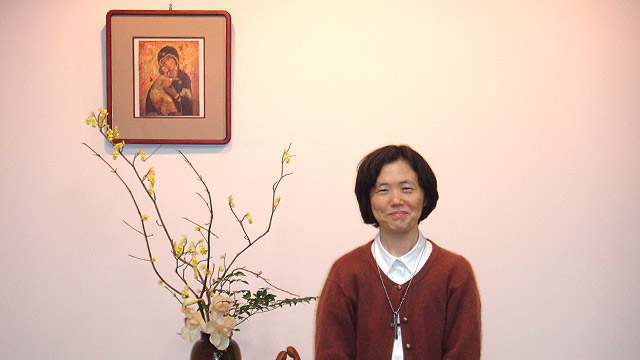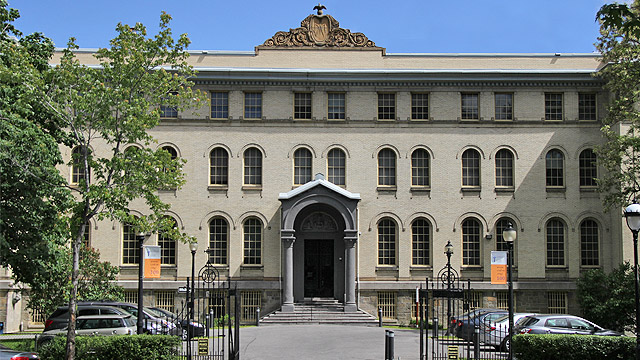

Seeking the heart of Marguerite Bourgeoys
Salt + Light Media
Monday, November 24, 2014

I am a sister of the Congrégation de Notre-Dame (CND). On April 1, 2013, I left Japan on a one-year assignment to be a member of the International Community located in the Mother House in Montreal. First, let me briefly introduce the history of the CND in Japan. It was in 1932 that five French Canadian sisters crossed the Pacific Ocean at the request of a Canadian Dominican bishop overseeing the Catholic Church in Tohoku District in Japan. The sisters established a mission in Fukushima City, a small agricultural town located 240 km northeast of Tokyo. Though the French speaking sisters could hardly communicate with the local people, they were warmly welcomed by a small group of Catholics as well as non-Catholics regardless of their religions. Their missionary work progressed in Fukushima City. They built a new convent building and opened a kindergarten. However, war clouds started hovering over Japan. In 1941, the Pacific War broke out. The convent was confiscated by the Japanese army and converted to an internment camp for foreign nationals. Some Canadian sisters returned to Canada, while others were put under house arrest and relocated to Aizu, an inland region of Fukushima Prefecture. They had no means of communication with the outside world and were obliged to live in deprivation. What saved them was the help of three Japanese candidates who had refused to leave the Congregation in spite of repeated advice from Japanese priests. They stayed with the Canadian sisters, secretly providing them with food and necessities. They prayed together and waited for peace. The war that started on the feast of Our Lady of the Immaculate Conception finally ended in 1945, on the Feast of the Assumption of the Blessed Virgin Mary. All of the Canadian sisters who were interned in Aizu could now return to Fukushima City. After the war, the sisters took war orphans under their wing. The following year, they opened an elementary school. Among the students were the war orphans. Since the war, CND schools in Japan have expanded. Now we have a kindergarten, an elementary school, a high school and a two-year college in Fukushima; a kindergarten and a girls’ residence in Tokyo; an elementary school, a middle school, and a high school in Kita-Kyushu. At present, seventy CND sisters including seven Canadian sisters are engaged in educative and apostolic works in Japan My parents are Catholic and I was baptised as an infant, which is quite unusual in Japan because the majority of Japanese classify themselves as both Shinto and Buddhist. I was educated in a CND school in Kita-Kyushu City for 12 years and studied for 4 years at a university in Tokyo living in the CND student residence in Chofu. It was at the elementary school that I first encountered Marguerite Bourgeoys when I was six years old. What I remember best during my school days is the smile of a Canadian sister of Irish decent. Her bright and kind smile never left her face or my memory. In the novitiate, I learned the history of the CND and music from one of the five pioneer sisters who came to Japan in 1932. Though she didn’t tell me in so many words about the difficulty and hardship she had experienced when she first arrived and especially during the war, I could sense the reason why she remained in Japan: her strong love for Jesus, Mary and our Foundress. She stayed in Japan because it was God’s will; because Mary was with her; and because Marguerite would have done the same. When I reflect on the sister’s life in the light of Marguerite’s, I seem to better understand Marguerite and her greatness. The sister died one year and 2 months before my first vows and I was given her cross. After making my perpetual vows, I became a teacher and taught Japanese at high schools in Fukushima and Kita-kyushu. It was a busy time, but interactions with young students were a rewarding experience. Some of our new students were heartbroken because they had failed entrance exams in other schools, but they were warmly welcomed at CND schools, where they learn: you are precious in my sight, and honoured (Isaiah 43:4). Nothing gave me more pleasure than to see them regain their self-confidence and get back on their feet. However, I sometimes questioned myself. Before entering religious life, I taught at a Protestant school and met many devoted lay teachers. They preach the word of God at morning worship, and then go to the classroom to teach and guide students. What’s the difference between them and a teacher like me, a sister? This question had been bothering me. When I was offered a one-year assignment to go to Montreal, I thought this might be an opportunity to step back from my teaching life, and to reflect on this question.

After arriving in Canada, I walked around Montreal, map in hand, whenever I had time. I visited museums and churches, starting with Notre-Dame-de-Bon-Secours Chapel. I visited Old Montreal where our Foundress opened the first school. I visited the Old Towers of the Grand Seminary where our sisters had taught Amerindian girls. I saw St. Marguerite’s portraits and statues in many churches. Many places were named after our Foundress. Everything I have seen and heard testifies to how dear she is to the people of Montreal. The historic and archaeological material taught me how hard Marguerite’s life was in her early days in Montreal. I walked around the Old Port of Montreal on November 16, the day when Marguerite landed at the port of Ville Marie almost five centuries ago. The air was already cool. The port looked deserted with most of the trees losing their leaves. Then came an extremely harsh winter! I re-read Marguerite’s writing and biographies. I could feel between the lines her solitude and fear of the unknown. In her native France, she made a private vow, lived a consecrated life and was involved in volunteer activities. But she chose to leave her comfort zone and had the courage to venture into a new world. Following God’s plan, she devoted herself to the service of the people and to the teaching of the Good News, the Gospel. She founded an extern religious community with companions. Looking back from present-day Montreal to those days in Ville Marie, I was moved more than ever by Marguerite’s courage and extraordinary accomplishment. There are lots of great people in the world who built a country. The greatness of Marguerite was not only in her contribution to building Ville Marie. It is above all having established a non-cloistered educative religious order for women. In her Writings, Marguerite writes about the love of a lover. She loved Jesus with this love, and wanted to live always in the presence of God, as a mother who loves her child intensely does not lose him from her sight.[1] Thus, a consecrated life was her natural choice of a way of life. In imitation of the Virgin Mary living with her neighbor, Marguerite lived with women having the same desire, served the people, and spread the Word of God. I think she wanted her community to be a model of human community and a living witness in this world. She desired most deeply that the commandments of love be engraved in her and her sisters’ minds: You shall love the Lord your God with all your heart, and with all your soul, and with all your mind… You shall love your neighbour as yourself.[2] Meeting with sisters engaged in various educative and apostolic ministries helped deepen my understanding of our Foundress. I have learned that living her charism is of the utmost importance to the sisters in their process of discerning, finding their vocation and ministry. We have to discern where we are and where we are called, through our dialogues with ourselves, with our superiors, with Jesus, and with Marguerite. What is required of us is to mature as a person and grow spiritually as a religious, as well as to understand the charism and living it passionately. Because I became too accustomed to a life of teaching in the protective environment of the CND schools, I might have lost sight of “why I was sent to this mission”. My mission is to embrace Jesus and pass along, by words and deeds, the good news that “You are precious in God’s sight. God loves you. You are of utmost importance to God." As Marguerite wished, my mission is to spread the commandment of love by building warm relationships with my sisters and co-workers. My mission is a total commitment to a consecrated life, and that is what early missionaries tried to pass down to later generations at the risk of their lives. Missionary sisters have brought many gifts to Japan: the Word of God, the spirituality of Marguerite Bourgeoys, education, religious life... I know I have received many gifts during my stay in Canada. However, when I think of what I have achieved in Canada, I am not sure. But one thing is certain: I talked about Fukushima. On March 11, 2011, earthquake and tsunami struck the northeastern coast of Japan. The earthquake completely demolished the convent built by the missionary sisters in 1935. This unprecedented disaster crippled the Fukushima Nuclear Power Plant. The radioactive contamination caused by the nuclear reactor meltdown has a devastating long-term health impact on the people of Fukushima. Many families left Fukushima to protect their children from radiation exposure. In fact, the number of students of the CND schools diminished a great deal. In our kindergarten alone, 40 % of children left Fukushima. Facing the dire reality, our sisters asked themselves what Marguerite would have done if she had been there, and launched various projects. First, they set up a scholarship program for afflicted students. They rebuilt a kindergarten, which features a playground enclosed by glass walls so that the children can play indoors without being exposed to contaminated air. Some sisters, with the collaboration of a number of dioceses, have a project to send children away from the radiation exposure to vacation sites during the summer holiday. Some sisters regularly visit victims still living in temporary housing to listen to their problems and concerns, or just to be with them. Recently, a group of volunteers joined this project. They offer emotional support to women facing uncertain futures, especially in regard to raising their children under such circumstances. Last summer I attended the CND Social Justice Network Meeting on behalf of the Japanese province, and introduced, using a PowerPoint Presentation made by sisters in Fukushima, the current status of Fukushima and how Japanese sisters are dealing with the difficult situations. The sisters and associates of the American province have set up a support project “the Blessed Sacrament CND Fukushima Solidarity Project. It is a great moral and financial support for our sisters. The American sisters have demonstrated a real sense of compassion, which was so dear to Marguerite. They remind me that I am really a member of the worldwide CND family. In April, I go back to Japan and will be assigned to Fukushima. I would like to continue to be a liaison between the Fukushima and North American sisters. I am returning to Japan embracing the heart of Marguerite Bourgeoys that I found in Montreal.[1] The italic texts are excerpts from the Writings of Marguerite Bourgeoys [2] Mathew 22:37-39 This post was written by Sr. Atsuko Nakamoto, CND, in March 2013. She is currently living and serving in Fukushima, Japan.
Related Articles:
<<













